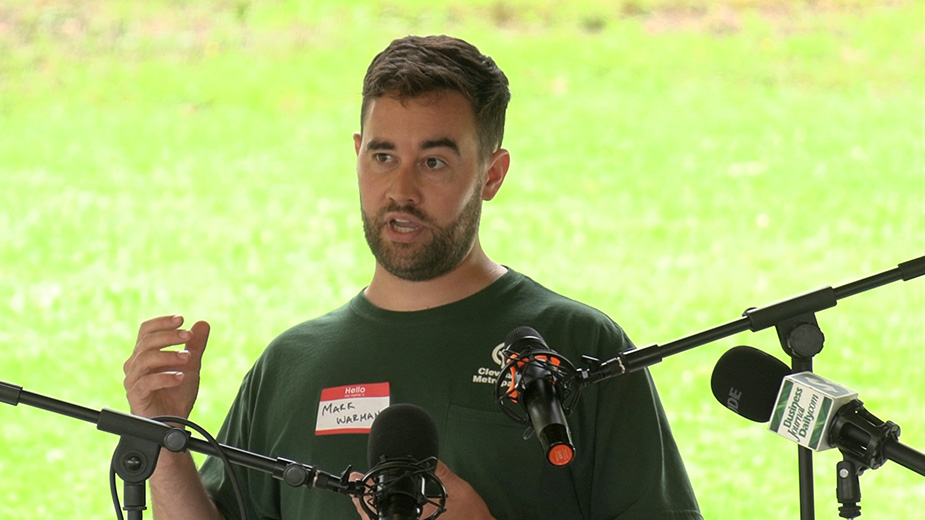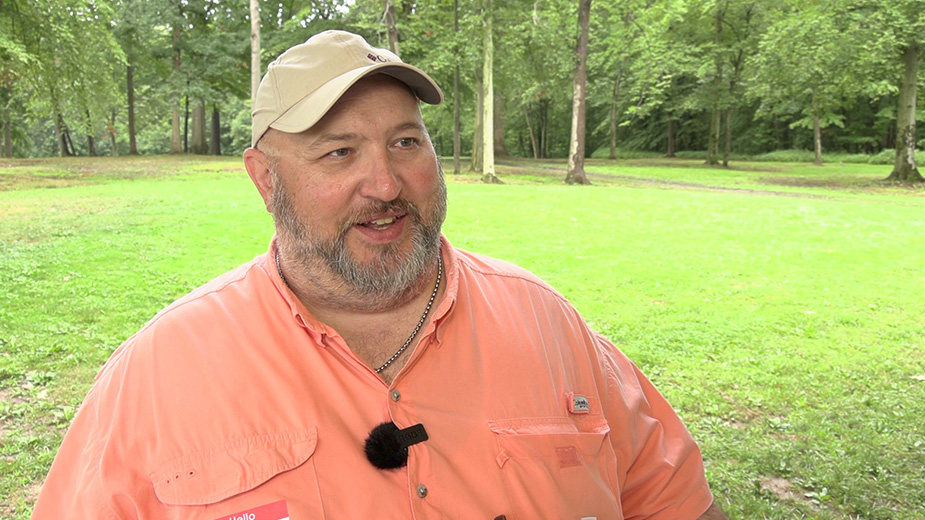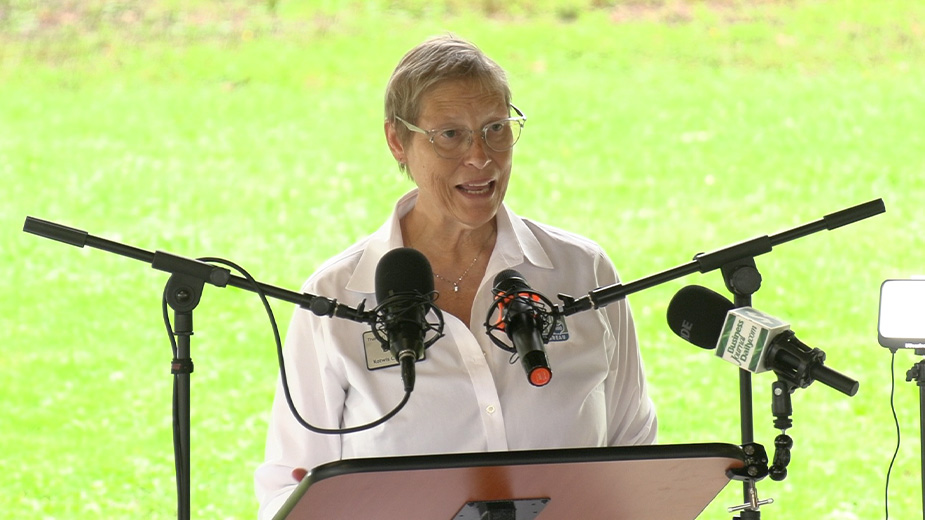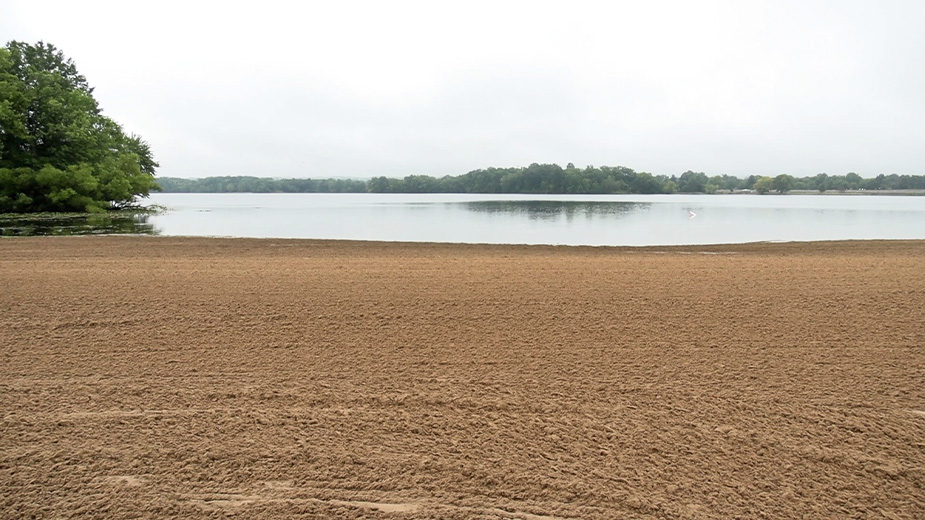Battle Rages to Rid Mosquito Lake of Invasive Plant
CORTLAND, Ohio – Mark Warman, an aquatic invasive species expert, was inspecting Pymatuning Lake by helicopter one day in 2021.
Since he and his crew had some flight time remaining, they decided to swing over to Mosquito Lake and give it a look.
It was then that they made an unfortunate discovery: hydrilla, a destructive submerged plant, had gained a foothold in the large lake in Trumbull County.
The good news was that they caught it early. Officials have since launched an effort to eradicate the plant before it can affect boating and fishing.
Preventing the hydrilla from spreading to other lakes has also become a priority, Warman said.
He was speaking Friday morning at a gathering of officials and stakeholders at Mosquito Lake State Park’s pavilion where information about the park was shared.
While plenty of good news about Mosquito Lake State Park’s growing appeal as a tourism destination was revealed at the event, the hydrilla invasion was the dominant topic.

Warman, who is employed by Cleveland Metroparks, said the hydrilla battle is a high priority within the Great Lakes watershed. The Mosquito effort is being watched closely by neighboring states where the species has not yet appeared.
“Hydrilla is the gold medal winner,” Warman said. “It pushes out all other plants and tries to take every available niche [of a lake]. It’s a warrior species.”
The plant grows in tangled, submerged masses that can reach to a depth of 12 feet. Like a potato, it sends tubers and shoots in all directions.
“Trying to target it in a 7,800-acre body of water is challenging,” he said.
Hydrilla currently occupies no more than 2% of the lake but grows rapidly.
Mosquito Lake has at least 28 species of submerged or floating plants, of which only four are invasive. None come close to being as destructive as hydrilla, which outcompetes every other plant. It forms dense mats, and currently is found in water up to 6 feet deep. If left unchecked, it will become the only type of aquatic plant in the lake within three to five years, Warman said.
The plant spreads from lake to lake by attaching itself to boats. For that reason, boaters are asked to clean the hull of their boats before putting them in a different body of water. Birds can also carry the plant to other lakes.
Boating is also a major attraction at Mosquito and another reason to eradicate the plant. Over time, hydrilla will choke the marina and make navigation very difficult.
The plant will also damage the fishery and lead to smaller and fewer fish because it reduces food sources.
“It can occupy a huge amount of space,” Warman said. “It tends to fly under the radar until it causes problems. We got an early detection, and we’d like to contain it and prevent it from spreading to other lakes.”
It can take seven to 10 years to get a hydrilla infestation down to nondetectable levels, Warman said.
Currently, Pymatuning is the only other lake in the northeastern Ohio region that is battling hydrilla. The species was discovered at Pymatuning in 2018.
The effort to eradicate the species is in at least its second year, and much of the funding is in place to continue it. The chemical treatment process costs $330,000 per year, according to Trumbull County Commissioner Denny Malloy.

The state has chipped in $330,000 for the task, with the Trumbull commissioners providing another $300,000, and the state natural resources department $50,000.
Currently, 80 acres of the lake have hydrilla. If left unchecked, it doubles in volume every year, Malloy said.
The Good News
Fortunately, there is plenty of positive news coming out of Mosquito Lake, which is the drinking water source for Warren, Howland, Cortland, Champion and Bazetta.
Mosquito is the second largest inland lake in the state, pointed out Beth Kotwis Carmichael, director of the Trumbull County Tourism Bureau. It’s second only to Grand Lake in western Ohio in size but outpaces it in visitation.
Mosquito Lake State Park logged 914,000 visits over the previous 12 months, with each visitor spending an average of three hours. That is far more than Lake Milton or West Branch, Carmichael pointed out.
As a tourism destination, it ranks No. 9 statewide. Cuyahoga Valley National Park tops the list with 5.8 million annual visits.
In 2019, the most recent data available, the park garnered $35 million in spending by visitors within the Trumbull area.
“The biggest challenge is the name,” Carmichael said, emphasizing that the park has no more mosquitos than any other body of water.
The lake is named for Mosquito Creek, the once-swampy waterway that was dammed in 1943.

Jon Dobney, assistant chief of the state’s natural resources department’s division of parks and watercraft, touted Mosquito’s viability as a fishing lake.
“The campground has logged 10,276 overnight stays so far this year, almost 1,100 more than last year,” Dobney said.
Fishing has a $6.4 billion annual economic impact in Ohio, Dobney said, and Mosquito Lake is in the top 12 of the state.
“There will be 119 fishing tournaments on the lake this year, an increase of almost 25% over last year,” he said.
Mosquito Lake is teeming with bass, walleye, crappie and sunfish.
Malloy has been hunting and fishing at the lake since he was a boy and recognizes it as a gem of the county. He would like to see improvements so it can reach its full potential.
“It looks the same as it did when I was 12,” said Malloy, who has heard from folks who want to keep it pristine and also from those who favor more development.
Malloy said the need for additional lodging at the lake is its greatest need. Visitors frequently are forced to head to Niles to find a room.
The lake attracts many daytrippers from the Cleveland area. Malloy refers to them as “Cuyahoga commandos” because they swarm in and out on the same day. He would like to get them to stay overnight.
“Mosquito Lake is a gem, a treasure, and it’s waiting for us to harness it,” he said. “Let’s think about that. We can do better.”
Pictured at top: Beneath the still surface of Mosquito Lake is a growing threat: hydrilla, an invasive submerged plant species.
Copyright 2024 The Business Journal, Youngstown, Ohio.



